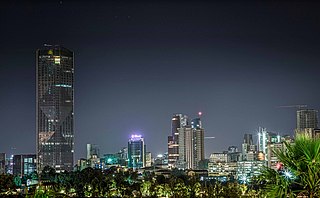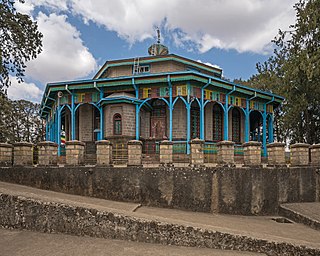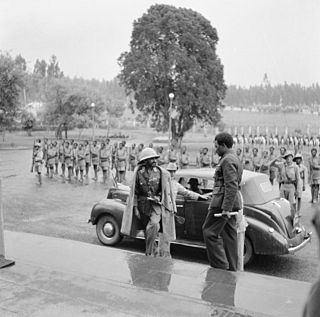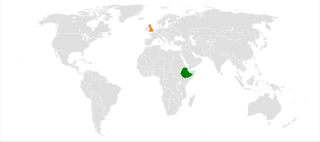
The Battle of Adwa was the climactic battle of the First Italo-Ethiopian War. The Ethiopian forces defeated the Italian invading force on Sunday 1 March 1896, near the town of Adwa. The decisive victory thwarted the campaign of the Kingdom of Italy to expand its colonial empire in the Horn of Africa. By the end of the 19th century, European powers had carved up almost all of Africa after the Berlin Conference; only Ethiopia and Liberia still maintained their independence. Adwa became a pre-eminent symbol of pan-Africanism and secured Ethiopian sovereignty until the Second Italo-Ethiopian War forty years later.

The First Italo-Ethiopian War also referred to as the First Italo-Abyssinian War;, was a war fought between Italy and Ethiopia from 1895 to 1896. It originated from the disputed Treaty of Wuchale, which the Italians claimed turned Ethiopia into an Italian protectorate. Full-scale war broke out in 1895, with Italian troops from Italian Eritrea achieving initial successes against Tigrayan warlords at Coatit, Senafe and Debra Ailà, until they were reinforced by a large Ethiopian army led by Emperor Menelik II. The Italian defeat came about after the Battle of Adwa, where the Ethiopian army dealt the heavily outnumbered Italian soldiers and Eritrean askaris a decisive blow and forced their retreat back into Eritrea. The war concluded with the Treaty of Addis Ababa. Because this was one of the first decisive victories by African forces over a European colonial power, this war became a preeminent symbol of pan-Africanism and secured Ethiopia's sovereignty until the Second Italo-Ethiopian War of 1935–36.

Haile Selassie I was Emperor of Ethiopia from 1930 to 1974. He rose to power as Regent Plenipotentiary of Ethiopia (Enderase) for Empress Zewditu from 1916 until 1930. Haile Selassie is widely considered a defining figure in modern Ethiopian history, and the key figure of Rastafari, a religious movement in Jamaica that emerged shortly after he became emperor in the 1930s. Before he rose to power he defeated Ras Gugsa Wole Bitul of Begemidr at the Battle of Anchem in 1928. He was a member of the Solomonic dynasty, which claims to trace lineage to Emperor Menelik I, believed to be the son of King Solomon and Makeda, the Queen of Sheba.

Addis Ababa is the capital and largest city of Ethiopia. In the 2007 census, the city's population was estimated to be 2,739,551 inhabitants. Addis Ababa is a highly developed and important cultural, artistic, financial and administrative centre of Ethiopia. It also serves as the capital of the Oromia Region.

Menelik II, baptised as Sahle Maryam was King of Shewa from 1866 to 1889 and Emperor of Ethiopia from 1889 to his death in 1913. At the height of his internal power and external prestige, the process of territorial expansion and creation of the modern empire-state was completed by 1898.

Taytu Betul was Empress of Ethiopia from 1889 to 1913 and the third wife of Emperor Menelik II. An influential figure in anti-colonial resistance during the late 19th-century Scramble for Africa, she, along with her husband, founded the modern Ethiopian capital Addis Ababa in 1886.

Mount Entoto is the highest peak on the Entoto Mountains, which overlooks the city of Addis Ababa, the capital of Ethiopia. It reaches 3,200 meters above sea level.
Addis Alem also known as Ejere (Oromo: Ejjeree, officially known as Ejere is a town in central Ethiopia. Located in the West Shewa Zone of the Oromia Region, west of Addis Ababa, this town has a latitude and longitude of 9°2′N38°24′E with an elevation of about 2360 meters above sea level.

The history of Addis Ababa, capital of Ethiopia, formally begins with the founding of the city in the 19th century by Ethiopian Emperor Menelik II and his wife Empress Taytu Betul. In its first years the city was more like a military encampment than a town. The central focus was the emperor’s palace, which was surrounded by the dwellings of his troops and of his innumerable retainers. In the 1920s, Addis Ababa experienced a significant economic upturn, marked by a surge in the number of middle-class-owned buildings, including stone houses furnished with imported European furniture. The middle class also introduced newly manufactured automobiles and expanded banking institutions. Urbanization and modernization persisted during the Italian occupation, guided by a masterplan aimed at transforming Addis Ababa into a more "colonial" city, a trajectory that continued beyond the occupation. Subsequent master plans, formulated from the 1940s onward with the input of European consultants, focused on the development of monuments, civic structures, satellite cities, and the inner city.

Ethiopia is a landlocked sovereign country located in the Horn of Africa. Ethiopia is bordered by Eritrea to the north, Sudan to the west, South Sudan to the south-west, Kenya to the south, Somalia to the east and Djibouti to the north-east. Ethiopia is one of the oldest countries in the world and Africa's second-most populous nation. Ethiopia has yielded some of humanity's oldest traces, making the area important in the history of human evolution. Recent studies claim that the vicinity of present-day Addis Ababa was the point from which human beings migrated around the world. Ethiopian dynastic history traditionally began with the reign of Emperor Menelik I in 1000 BC. The roots of the Ethiopian state are similarly deep, dating with unbroken continuity to at least the Aksumite Empire and its predecessor state, D`mt. After a period of decentralized power in the 18th and early 19th centuries known as the Zemene Mesafint, the country was reunited in 1855 by Kassa Hailu, who became Emperor Tewodros II, beginning Ethiopia's modern history. Ethiopia's borders underwent significant territorial expansion to its modern borders for the rest of the century, especially by Emperor Menelik II and Ras Gobena, culminating in its victory over the Italians at the Battle of Adwa in 1896 with the military leadership of Ras Makonnen, and ensuring its sovereignty and freedom from colonization. It was occupied by Benito Mussolini's Fascist Italy from 1936 to 1941, ending with its liberation by British Empire and Ethiopian Patriot forces. Its eastern border also changed in 1950 from the former 1908 Convention Line to the subsequent provisional administrative line.
The Siltʼe people are an ethnic group in southern Ethiopia. They inhabit the Siltʼe Zone which is part of the Southern Nations, Nationalities and Peoples Region. Silt'e people speak Siltʼe language a Semitic language which is closely related to Wolane, Zay and Harari languages.

Italians of Ethiopia are Ethiopian-born citizens who are fully or partially of Italian descent, whose ancestors were Italians who emigrated to Ethiopia starting in the 19th century during the Italian diaspora, or Italian-born people in Ethiopia.

The Menelik Palace, also known as the Imperial Palace or Great Ghebbi, is a palatial compound in Addis Ababa, Ethiopia. Previously for years was known as the Gebbi, it was the seat of the power of the Emperors of Ethiopia. Within its confines are several residences, halls, chapels, and working buildings. Today it contains the offices and residence of the Prime Minister of Ethiopia.
The following is a historical events of Addis Ababa, the capital of Ethiopia, including its formation prior to 20th century by chronology.

Arada is a district of Addis Ababa, Ethiopia. As of 2011 its population was of 226,000. Arada is one of 10 districts of Addis Ababa, the capital of Ethiopia. Arada is a center of culture and education, with a great number of schools, cultural establishments and annual cultural events. Arada is one of the oldest parts of Addis Ababa and early history is most apparent. Its narrow, sloping streets are dotted with beautiful old one- and two-storey buildings variously adorned with verandas, pillars, bay windows and other decorations in accordance with Indian, Middle-Eastern and European styles. Despite that, there are newer areas. The district's heart is Piazza, a bustling commercial area centered on De Gaulle Square; the imposing city hall, the seat of the city government, built in 1965, and the octagonal neoclassical St Georges Cathedral, built to commemorate Emperor Menelik's defeat of the Italians in the battle of Adwa in 1896 and named after Ethiopia's patron saint Its bustling streets are dotted with stores and boutiques offering European clothing, jewelry, and a variety of other things at relatively greater rates than in other sections of the city.

During World War I, Ethiopia briefly forged an alliance with the Allied Powers, following Italy's entry into the war in 1915. In June 1916, a dynastic conflict emerged when the uncrowned Emperor, Lij Iyasu, was alleged to have converted to Islam under the influence of the Ottoman Empire, which led him to be charged with apostasy. As a result, then-regent Ras Tafari Mekonnen, later known as Emperor Haile Selassie, orchestrated a coup d'état in September, deposing Lij Iyasu and installing Empress Zewditu on the throne. Throughout the war, Empress Zewditu maintained a stance of neutrality.

Ethiopia–United Kingdom relations are bilateral relations between Ethiopia and the United Kingdom. Currently, Ethiopia has an embassy in London and United Kingdom has an embassy in Addis Ababa. Historically, their relations traced over centuries covered a range of areas including, but not limited to, trade, culture, education and development cooperation. The UK is the first country to open its embassy in Addis Ababa. Ethiopia is the first African country to open embassy in London.

The relations between Oromia and Addis Ababa has been great controversy as the subject sparked historical revisionism in the linkage of history of Addis Ababa. The area in the present day Addis Ababa called Finfinne where various Oromo pastoralists inhabited the region, and the emergence of Abyssinian expansionism under Emperor Menelik II which renamed the area as Addis Ababa in 1886. Throughout the 20th century, Addis Ababa was governed as the capital city of the Ethiopia under urban influence.

Entoto Maryam Church is one of the oldest Ethiopian Orthodox Tewahedo Churches on the Entoto Hills, 2.5 km away from Addis Ababa, Ethiopia. It was built in 1877 by Emperor Menelik II and the burial place of Menelik and his wife Empress Taytu. Several royal artifacts of the emperor and empress also found in this church.

















